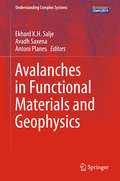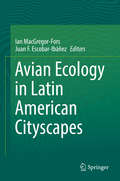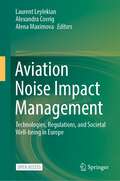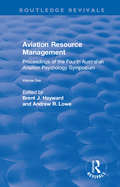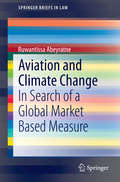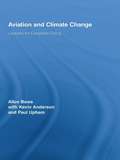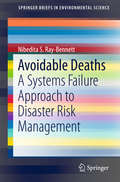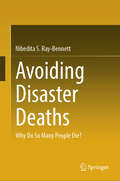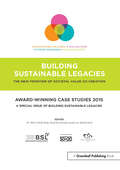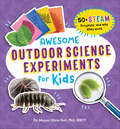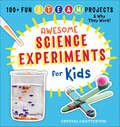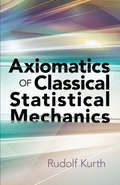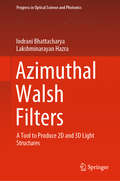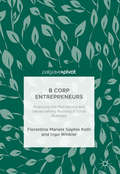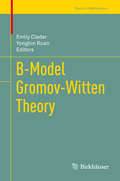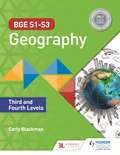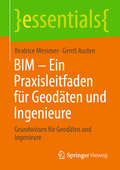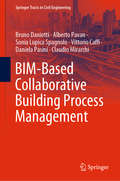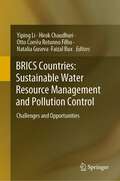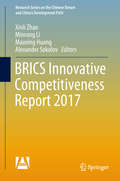- Table View
- List View
Avalanches in Functional Materials and Geophysics (Understanding Complex Systems)
by Avadh Saxena Antoni Planes Ekhard K. H. SaljeThis book provides the state-of-the art of the present understanding of avalanche phenomena in both functional materials and geophysics. The main emphasis of the book is analyzing these apparently different problems within the common perspective of out-of-equilibrium phenomena displaying spatial and temporal complexity that occur in a broad range of scales. Many systems, when subjected to an external force, respond intermittently in the form of avalanches that often span over a wide range of sizes, energies and durations. This is often related to a class of critical behavior characterized by the absence of characteristic scales. Typical examples are magnetization processes, plastic deformation and failure occuring in functional materials. These phenomena share many similarities with seismicity arising from the earth crust failure due to stresses that originate from plate tectonics.
Avian Ecology in Latin American Cityscapes
by Ian MacGregor-Fors Juan F. Escobar-IbáñezThis book gathers a representative sample of the relevant knowledge related to the ecology, behavior, and conservation of birds in urban Latin America. Latin America is one of the most biodiverse regions of the world, yet it is still understudied. Although it concentrates most of its population in rapidly growing cities under considerable economic, social, and environmental disparity, the study of the effects that urbanization has on biodiversity in Latin America is still insufficient. Among the best-studied wildlife groups, birds have been widely used as bioindicators in urban areas. Going from general to specific information regarding avian communities, populations, behavior, threats, and conservation issues, this book describes the state-of-the-art of avian urban ecology in the region. Such knowledge will hopefully promote the regional consolidation of the field and encourage future mechanistic studies that untangle the recorded patterns in order to have the required information to bridge the gap between evidence-based knowledge and practice in urban systems. Thus, the information included in this document will allow scientists, students, and even decision takers to relate with the current knowledge and gaps related to the topic, providing perspective for future studies and actions.
Aviation Noise Impact Management: Technologies, Regulations, and Societal Well-being in Europe
by Laurent Leylekian Alexandra Covrig Alena MaximovaThis open access book provides a view into the state-of-the-art research on aviation noise and related annoyance. The book will primarily focus on the achievements of the ANIMA project (Aviation Noise Impact Management through Novel Approaches), but not exclusively.The content has a broader theme in order to encompass. regulation issues, the ICAO (International Civil Aviation Organization) balanced approach, progresses made on technologies and reduction of noise at source, impact of possible future civil supersonic aircraft, land-use planning issues, as well as the core topics of the ANIMA project, i.e. impact on human beings, annoyance, quality of life, health and findings of the project in this respect.This book differs from traditional research programmes on aviation noise as the authors endeavour, not to lower noise at source, but to reduce the annoyance. This book examines these non-acoustic factors in an effort to help those most affected by aviation noise – communities living close to airports, and also help airport managers, policy-makers, local authorities and researchers to deal with this issue holistically. The book concludes with some recommendations for EU, national and local policy-makers, airport and aviation authorities, and more broadly a scientifically literate audience. These recommendations may help to identify gaps for progress in terms of research but also genuine implementation actions for political and regulatory authorities.
Aviation Resource Management: Proceedings of the Fourth Australian Aviation Psychology Symposium Volume 1 (Routledge Revivals)
by BRENT J. HAYWARD AND ANDREW R. LOWEThis title was first published in 2000. This is volume one of a two-volume set which presents the reader with strategies for the contributions of psychology and human factors to the safe and effective functioning of aviation organizations and systems.Together, the volumes comprise the edited contributions to the Fourth Australian Aviation Psychology Symposium. The chapters within are orientated towards presenting and developing practical solutions for the present and future challenges facing the aviation industry. Each volume covers areas of vital and enduring importance in the complex aviation system. Volume one includes aviation safety, crew resource management, the aircraft cabin, cockpit automation, safety investigation, fatigue and stress, and applied human factors in training.
Aviation Weather Services
by Federal Aviation Federal Aviation Administration<p>Published the Federal Aviation Administration (FAA), with the participation of the National Weather Service, this FAA Advisory Circular (AC) 00-45H explains the U.S. aviation weather products and services available to pilots. With full-color illustrations throughout, it details the interpretation and application of advisories, coded weather reports, forecasts, observed and prognostic weather charts, and radar and satellite imagery. <p>Readers will find full coverage of weather-related tools to assist every pilot’s flight planning and in‑flight decisions. Weather product examples and explanations are supported with hundreds of weather website references for further resources, definitions, and additional related FAA publications. Applicable to both VFR and IFR pilots, low and high-altitude operations, this new edition now includes weather resources for soaring, space, and helicopter emergency medical services (HEMS). <p>This book is the weather services resource to use when studying for pilot certification exams and should remain a part of every aviator’s library. Subjects covered include METARs, Pilot Reports (PIREPs), the new Graphical Forecast for Aviation (GFA), SIGMETs, AIRMETs, Terminal Aerodrome Forecasts (TAF), Significant Weather Charts and much more. With additional weather station location tables, symbols and conversion charts, internet links and more, this book is key for all pilots seeking an understanding of the weather resources available for preflight and inflight decision-making.</p>
Aviation Weather Services: A Call for Federal Leadership and Action
by National Aviation Weather Services CommitteeEach time we see grim pictures of aircraft wreckage on a rain-drenched crash site, or scenes of tired holiday travelers stranded in snow-covered airports, we are reminded of the harsh impact that weather can have on the flying public. This book examines issues that affect the provision of national aviation weather services and related research and technology development efforts. It also discusses fragmentation of responsibilities and resources, which leads to a less-than-optimal use of available weather information and examines alternatives for responding to this situation. In particular, it develops an approach whereby the federal government could provide stronger leadership to improve cooperation and coordination among aviation weather providers and users.
Aviation Weather Services: Advisory Circular (FAA Handbooks)
by Federal Aviation AdministrationPublished the Federal Aviation Administration (FAA), with the participation of the National Weather Service, this FAA Advisory Circular (AC) 00-45H explains the U.S. aviation weather products and services available to pilots. it details the interpretation and application of advisories, coded weather reports, forecasts, observed and prognostic weather charts, and radar and satellite imagery. <P><P>Readers will find full coverage of weather-related tools to assist every pilot’s flight planning and in‑flight decisions. Weather product examples and explanations are supported with hundreds of weather website references for further resources, definitions, and additional related FAA publications. <P><P>This book is the weather services resource to use when studying for pilot certification exams. This book is key for all pilots seeking an understanding of the weather resources available for preflight and inflight decision-making.
Aviation and Climate Change: In Search of a Global Market Based Measure (SpringerBriefs in Law)
by Ruwantissa AbeyratneThe book addresses the most critical issue faced by aviation and climate change: namely the development of a market based measure to control aircraft engine emissions. It discusses the current market economic trends as they impact to aviation and suggests steps and measures to be taken in the development of a workable MBM. ICAO has three years to come up with such an MBM on a global scale and this book will spur discussions on how to achieve this objective.
Aviation and Climate Change: Lessons for European Policy (Routledge Studies in Physical Geography and Environment #Vol. 8)
by Kevin Anderson Paul Upham Alice BowsIt is generally accepted – the US administration excepted - that the emissions reduction targets agreed in the Kyoto Protocol are only the beginning of what needs to be achieved in international climate negotiations. While studies suggest that major emission reductions by industrialized countries can be achieved at low economic cost, both these and early reductions by developing countries are inevitably a major political challenge. This book focuses on European policy toward climate change, specifically its ramifications for the aviation industry. With air travel predicted to grow enormously in the coming years, the issue of climate change is hugely topical for this important industry. Accessible to students, academics and practioners, this book is useful reading for all those with an interest in climate change, the aviation industry, or both.
Avoidable Deaths
by Nibedita S. Ray-BennettThis book addresses one of the most fundamental questions of the 21st century: why deaths continue to occur in natural disasters despite the tremendous advancements in disaster management science and weather forecasting systems, increased sophistication of human-built environments and ongoing economic and policy development worldwide. By presenting an interdisciplinary tool for analysing ‘systems failure’, the book provides concrete suggestions on how deaths may be reduced in resource-poor contexts. It goes beyond traditional risk and vulnerability perspectives and demonstrates that deaths in disasters are complex problems that can be solved by adopting a socio-technical perspective to improve current disaster management systems in the developing world. The book is a timely contribution, as it directly addresses Global Target One of the UN’s ‘Sendai Framework for Disaster Risk Reduction’, which has urged 185 UN Member States to reduce disaster mortality by 2030. Further, it offers a valuable resource for students, researchers, policy-makers and practitioners interested in disaster risk reduction, human rights, gender, sociology of risk, crisis and disasters, environmental science, organisation and management studies.
Avoiding Disaster Deaths: Why Do So Many People Die?
by Nibedita S. Ray-BennettThis book introduces a pathbreaking approach called &‘Avoidable Disaster Deaths&’ (ADD) to reduce disaster deaths. Disaster deaths are the direct and indirect impact of hazards. The &‘Sendai Framework for Disaster Risk Reduction&’ has urged the United Nations Member States to reduce disaster deaths or mortality by 2030. Reducing the number of disaster deaths has become a useful marker for improving disaster risk management. Equally important is knowing how people die, who dies, why they die, and which disaster deaths are &‘avoidable&’ and &‘unavoidable&’. Disaster risk reduction specialists have not fully examined these questions. Built from disaster risk reduction, public health, epidemiology, human geography, risk and crisis management studies, the ADD approach disaggregates disaster deaths into avoidable and unavoidable. Avoidable disaster deaths are preventable, amenable and governance-related. Unavoidable deaths are those that occur annually due to natural causes or poverty-related diseases. In a disaster climate, the emphasis should be on reducing avoidable disaster deaths in a resource-constrained context. Using the context of COVID-19 and the economic lockdown in India, the analytical advantage of this approach is explored. Doing so, the book brings forth human stories whose lives were cut short and introduces novel matrices and dynamic strategies to ascertain the &‘cause and circumstances&’ of avoidable disaster deaths to develop the capacity of disaster and health responders. The book is suitable for students, academics, policy-makers and practitioners interested in disaster risk reduction, human rights, risk and crisis management, environmental science, human geography, Sustainable Development and Sendai Goals. The book is also suitable for passionate citizens who want to capture the number, causes and circumstances of avoidable disaster deaths and take positive action to save lives in their communities. Professor Nibedita S. Ray-Bennett ably presents a novel &‘avoidable disaster deaths&’ approach to disaster risk reduction and management by presenting cogent arguments rooted in solid theory and up to date literature reviews, complemented by a wealth of data and analysis from the Indian Covid 19 experience. The book includes a range of tables and diagrams that crystallise approaches and practices useful for policy makers and practitioners alike. The book is highly informed, well written, accessible, practical and useful, with an optimal mix of strong, well-tested academic theory, and important recommendations that demand serious consideration by all involved and interested in disasters. A spur to action and inspiration. (Professor Michael Petterson, School of Social Sciences, Auckland University of Technology, New Zealand)
Award-winning Case Studies 2015: A Special Issue of Building Sustainable Legacies
Breaking with academic tradition, this journal offers a unique selection of articles that are written by looking at the future challenges first and then translating these into present times. The right-aligned layout is a material way of reminding us of the fact that “no problem can be solved from the same level of consciousness that created it” (A. Einstein). The journal provides hands-on, pragmatic and user-friendly research, suggestions and case studies as a resource for organisations that are committed to implementing sustainability. It is high time to build bridges between business and academia, with the clear purpose of helping business become truly sustainable. There are four dimensions to the journal: 1. Understand sustainability challenges 2. Specific dimensions of business sustainability 3. Exciting new solutions to implement 4. Case studies of leading business examples. In addition, produced is a special issue annually dedicated to an important theme. This is a special Issue of Building Sustainable Legacies.
Awesome Outdoor Science Experiments for Kids: 50+ STEAM Projects and why they work (Awesome STEAM Activities for Kids)
by Megan Olivia HallExplore the outdoors with hands-on science activities for kids ages 5 to 10Kids are full of big questions like "What makes plants grow?" or "Why does the moon change shape in the sky?". Awesome Outdoor Experiments for Kids can help them find the answers! It's a treasure trove of outdoor adventures, with more than 50 fun experiments that show kids science in action as they play outside.Every experiment focuses on at least one aspect of STEAM: science, technology, engineering, arts, and math. As kids explore each activity outdoors, they'll get the chance to interact with nature and the amazing processes that are happening all around them. They'll observe bug behavior, build a beaver dam, predict the weather, and so much more.Discover the ultimate guide to an outdoor science lab for kids:Easy to do at home—The activities use basic items that are probably already around the house and include easy-to-follow steps.Hows and whys—Kids will learn the real science behind every result with simple explanations of what happened, tips for exploring more, and fascinating questions to think about.Just for kids—Little ones might need a little help from a grown-up for certain steps, but these experiments are designed for kids to do all by themselves.Get kids outdoors with a book of hands-on experiments that show them the power of nature!
Awesome Science Experiments for Kids: 100+ Fun STEAM Projects & Why They Work! (Awesome STEAM Activities for Kids)
by Crystal ChattertonThe ultimate science experiment book for kids! 100+ hands-on projects to get kids ages 5 to 10 excited about science.As kids grow older, they become more curious about the world around them, often asking, "How does this work?" Awesome Science Experiments for Kids teaches young brains the nuts and bolts of the scientific method using fun, hands-on experiments designed to show kids how to hypothesize, experiment, and then record their findings.It's great for fun anytime, but especially for turning your child's summer break into a period of fun-filled summer learning! With awesome projects like a Fizzy Rocket, Magnet-Powered Car, and Pencil Sundial, kids will have a blast learning to build, design, and think critically—while getting inspired to interact with the world around them and make their own discoveries. An amazing summer learning workbook, it guides young readers through numerous exciting projects that demonstrate the elegance and wonder of science in the most enjoyable way possible.Awesome Science Experiments for Kids includes:100+ STEAM experiments—Each activity includes an explanation of the processes in play, so kids can understand how and why each project works.Easy instructions—These step-by-step science experiments for kids simplify each process to make the projects fun and simple to understand—and they only require basic household materials.Colorful photos—Refer to real-life photos that show you how to bring these experiments to life.From learning how quicksand works to turning a lemon into a battery, these experiments teach budding STEAM kids how cool it is to be curious.
Axiomatics of Classical Statistical Mechanics (Dover Books on Physics #Volume 11)
by Rudolf KurthRequiring only familiarity with elements of calculus and analytical geometry, this monograph constructs classical statistical mechanics as a deductive system, based on equations of motion and basic postulates of probability. 1960 edition.
Azimuthal Walsh Filters: A Tool to Produce 2D and 3D Light Structures (Progress in Optical Science and Photonics #10)
by Indrani Bhattacharya Lakshminarayan HazraThis book explores the possibility of using azimuthal Walsh filters as an effective tool for manipulating far-field diffraction characteristics near the focal plane of rotationally symmetric imaging systems. It discusses the generation and synthesis of azimuthal Walsh filters, and explores the inherent self-similarity presented in various orders of these filters, classifying them into self-similar groups and sub-groups. Further, it demonstrates that azimuthal Walsh filters possess a unique rotational self-similarity exhibited among adjacent orders. Serving as an atlas of diffraction phenomena with pupil functions represented by azimuthal Walsh filters of different orders, this book describes how orthogonality and self-similarity of these filters could be harnessed to sculpture 2D and 3D light distributions near the focus.
B Corp Entrepreneurs: Analysing the Motivations and Values behind Running a Social Business
by Ingo Winkler Florentine Mariele RothHighlighting the motivations of B Corp entrepreneurs in Chile, this book explores the phenomenon behind for-profit organisations that are committed to social and ecological sustainability as well as human welfare. By examining the personal and social drivers of businesses which are not solely focused on profit-making, the authors reveal a dual orientation that is an important factor in the creation of hybrid organisations. Offering an in-depth study of B Corp entrepreneurs in Chile, the largest B Corp community outside of North America, this pioneering book challenges dominant assumptions that there is only one ideal type of entrepreneur and argues that the values of the purely profit-driven and purely social-driven do in fact intersect. An enlightening read for researchers of social business and sustainability, this book analyses perceptions towards success, and the desire to solve environmental problems, underlining a fundamental aspect of the entrepreneur’s personal value structure.
B-Model Gromov-Witten Theory (Trends in Mathematics)
by Emily Clader Yongbin RuanThis book collects various perspectives, contributed by both mathematicians and physicists, on the B-model and its role in mirror symmetry. Mirror symmetry is an active topic of research in both the mathematics and physics communities, but among mathematicians, the “A-model” half of the story remains much better-understood than the B-model. This book aims to address that imbalance. It begins with an overview of several methods by which mirrors have been constructed, and from there, gives a thorough account of the “BCOV” B-model theory from a physical perspective; this includes the appearance of such phenomena as the holomorphic anomaly equation and connections to number theory via modularity. Following a mathematical exposition of the subject of quantization, the remainder of the book is devoted to the B-model from a mathematician’s point-of-view, including such topics as polyvector fields and primitive forms, Givental’s ancestor potential, and integrable systems.
BGE S1–S3 Geography: Third and Fourth Levels
by Carly BlackmanSyllabus: CfE (Curriculum for Excellence, from Education Scotland) and SQALevel: BGE S1-S3: Third and Fourth LevelSubject: GeographyTake your pupils on a journey where they will think, question and explore like geographers, developing their geographical skills, knowledge and understanding throughout S1-S3.Covering all CfE Third and Fourth Level Benchmarks for Social Studies: People, Place and Environment, this ready-made and fully differentiated BGE Geography course puts progression for every pupil at the heart of your curriculum.- Build understanding of geographical ideas, issues and processes: Clear explanations, diagrams and definitions of key words make the content accessible and engaging for all pupils- Interpret, analyse and evaluate geographical data: Pupils will practise and improve their geographical skills by completing a range of activities that involve maps, photos, graphs and case studies - with answers provided at the back of the book- Meet the needs of each pupil in your class: The content and activities are designed to ensure accessibility for those with low prior attainment, while extension tasks will stretch and challenge higher ability pupils- Effectively check and assess progress: All activities support formative assessment, helping you monitor progression against the Experiences & Outcomes and Benchmarks (with additional assessments and worksheets in the separate Planning & Assessment Pack)- Lay firm foundations for National qualifications: The skills, knowledge and understanding established through the course will set pupils up for success at National 5 and beyond- Deliver the 'responsibility for all' Es and Os: Plenty of activities that address literacy, numeracy and health and wellbeing skills are threaded through the book
BGE S1–S3 Geography: Third and Fourth Levels
by Carly BlackmanSyllabus: CfE (Curriculum for Excellence, from Education Scotland) and SQALevel: BGE S1-S3: Third and Fourth LevelSubject: GeographyTake your pupils on a journey where they will think, question and explore like geographers, developing their geographical skills, knowledge and understanding throughout S1-S3.Covering all CfE Third and Fourth Level Benchmarks for Social Studies: People, Place and Environment, this ready-made and fully differentiated BGE Geography course puts progression for every pupil at the heart of your curriculum.- Build understanding of geographical ideas, issues and processes: Clear explanations, diagrams and definitions of key words make the content accessible and engaging for all pupils- Interpret, analyse and evaluate geographical data: Pupils will practise and improve their geographical skills by completing a range of activities that involve maps, photos, graphs and case studies - with answers provided at the back of the book- Meet the needs of each pupil in your class: The content and activities are designed to ensure accessibility for those with low prior attainment, while extension tasks will stretch and challenge higher ability pupils- Effectively check and assess progress: All activities support formative assessment, helping you monitor progression against the Experiences & Outcomes and Benchmarks (with additional assessments and worksheets in the separate Planning & Assessment Pack)- Lay firm foundations for National qualifications: The skills, knowledge and understanding established through the course will set pupils up for success at National 5 and beyond- Deliver the 'responsibility for all' Es and Os: Plenty of activities that address literacy, numeracy and health and wellbeing skills are threaded through the book
BIM – Ein Praxisleitfaden für Geodäten und Ingenieure: Grundwissen für Geodäten und Ingenieure (essentials)
by Beatrice Messmer Gerrit AustenZiel dieses Essentials ist es, Basiswissen zu Building Information Modeling (BIM) für den Fachbereich der Geodäsie und deren Nachbardisziplinen aus nationaler sowie internationaler Literatur zusammenzufassen und praktische Empfehlungen daraus abzuleiten. Der zunehmende Digitalisierungsgrad bei Bauvorhaben durch die Anwendung von BIM und das steigende Automatisierungspotential klassischer geodätischer Tätigkeiten begründen die Notwendigkeit, betroffene Aufgaben- und Tätigkeitsfelder in der Vermessung weiter zu entwickeln.
BIM-Based Collaborative Building Process Management (Springer Tracts in Civil Engineering)
by Bruno Daniotti Alberto Pavan Sonia Lupica Spagnolo Vittorio Caffi Daniela Pasini Claudio MirarchiThe book reports on the great improvements in the information and knowledge management due to the digitalization of the building sector. By summarizing several research projects addressing the implementation of BIM in different stages of the building process, and the definition of standards at Italian, European and international levels for managing information relying on the implementation of BIM-based processes, it showcases the efforts, especially within the Italian building sector, to build a standardized structure of information and develop tools for collecting, sharing and exchanging information between stakeholders involved in different stages of the building process, so as to enhance the storage, traceability, usability and re-usability of information management. Further, it presents an enhanced use of information that relies on the adoption of the standardized structure of information, and proposes dedicated applications for automating the process of information fruition. Lastly, it features a digital platform for different stakeholders in the building sector, such as manufacturers, producers and construction companies.
BP Blowout: Inside the Gulf Oil Disaster
by Daniel JacobsBP Blowout is the first comprehensive account of the legal, economic, and environmental consequences of the 2010 oil disaster in the Gulf of Mexico. The accident destroyed the Deepwater Horizon oil rig and killed eleven people. The resulting offshore oil discharge, the largest ever in the United States, polluted much of the Gulf for months, wreaking havoc on its inhabitants.A former Justice Department lawyer responsible for enforcing environmental laws, Daniel Jacobs tells the story that neither BP nor the federal government want heard: how the company and the government fell short, both in terms of preventing and coping with the accident.All-important details about the cause and aftermath of the disaster have emerged through court proceedings and with the passage of time. The key finding of the federal judge who presided over the civil litigation arising out of the disaster was that the Deepwater Horizon blowout resulted from BP's gross negligence.BP has paid tens of billions of dollars to settle claims and lawsuits arising from the accident. The company also has pled guilty to manslaughter in a separate criminal case. Yet, no one responsible for the accident itself is headed to prison. On the other hand, hundreds of people have been prosecuted for filing false claims against BP, some seventy-five of whom have been sentenced to prison.BP Blowout is an important book for readers interested in the environment, sustainability, public policy, leadership, and the consequences of poor risk management.
BRICS Countries: Challenges and Opportunities
by Faizal Bux Yiping Li Hirok Chaudhuri Otto Corrêa Rotunno Filho Natalia GusevaThis book provides a detailed study and assessment of water resources management andpollution control in different BRICS countries. The regions involved areBrazil, Russia, India, China and South Africa. This book gives importantinsight into how future sustainability depends on the development of effectivewater governance mechanisms at the level of countries. According to theregional characteristics from different aspects it cuts into the waterenvironment problems and studies in different ways, which is multifaceted andtargeted. Using case studies that include environmentally integrated basinexperiments (eibex) of Brazil, groundwater overflow zone of India, semi-aridriver basin of South Africa and so on, this volume provides criticalinformation for researchers and policymakers.
BRICS Innovative Competitiveness Report 2017 (Research Series on the Chinese Dream and China’s Development Path)
by Alexander Sokolov Xinli Zhao Minrong Li Maoxing HuangThe Report predicts that the coming five years will witness the five countries keep improving in national innovative competitiveness, with China and Russia maintaining their strong growth momentum, India growing at a moderate rate, and Brazil and South Africa gradually picking up speed and climbing out of the trough. It estimates that the five countries’ national innovative competitiveness will be keeping steady growth by 2030. The General Reports part presents a comprehensive analysis of the current status and achievements of STI cooperation between China and other BRICS countries and proposes priority areas of BRICS STI cooperation to provide valuable decision inputs for the BRICS countries to accelerate the improvement of their national innovative competitiveness. The Country Reports part respectively analyzes and makes predictions on the national innovative competitiveness of the BRICS countries based on a survey of their STI development and STI cooperation within the BRICS framework. The Thematic Reports part focuses on four thematic areas closely related to STI, i.e. digital economy, financial inclusion, energy, and agriculture, and offers detailed analysis of the STI development and potential of the countries in relevant areas, providing additional inputs for a further understanding of the national innovative competitiveness of the BRICS countries.
